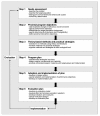How to develop a program to increase influenza vaccine uptake among workers in health care settings?
- PMID: 21595877
- PMCID: PMC3115899
- DOI: 10.1186/1748-5908-6-47
How to develop a program to increase influenza vaccine uptake among workers in health care settings?
Abstract
Background: Apart from direct protection and reduced productivity loss during epidemics, the main reason to immunize healthcare workers (HCWs) against influenza is to provide indirect protection of frail patients through reduced transmission in healthcare settings. Because the vaccine uptake among HCWs remains far below the health objectives, systematic programs are needed to take full advantage of such vaccination. In an earlier report, we showed a mean 9% increase of vaccine uptake among HCWs in nursing homes that implemented a systematic program compared with control homes, with higher rates in those homes that implemented more program elements. Here, we report in detail the process of the development of the implementation program to enable researchers and practitioners to develop intervention programs tailored to their setting.
Methods: We applied the intervention mapping (IM) method to develop a theory- and evidence-based intervention program to change vaccination behaviour among HCWs in nursing homes.
Results: After a comprehensive needs assessment, we were able to specify proximal program objectives and selected methods and strategies for inducing behavioural change. By consensus, we decided on planning of three main program components, i.e., an outreach visit to all nursing homes, plenary information meetings, and the appointment of a program coordinator -- preferably a physician -- in each home. Finally, we planned program adoption, implementation, and evaluation.
Conclusion: The IM methodology resulted in a systematic, comprehensive, and transparent procedure of program development. A potentially effective intervention program to change influenza vaccination behaviour among HCWs was developed, and its impact was assessed in a clustered randomised controlled trial.
Figures
References
-
- Cools HJ, van Essen GA. Practice guideline 'Influenza prevention in nursing homes and care homes,' issued by the Dutch Society of Nursing Home Specialists [article in Dutch, Englisch abstract] Ned Tijdschr Geneeskd. 2005;149:119–124. - PubMed
-
- Thomas RE, Jefferson T, Lasserson TJ. Influenza vaccination for healthcare workers who work with the elderly. Cochrane.Database.Syst.Rev. 2010;2:CD005187. - PubMed
Publication types
MeSH terms
Substances
LinkOut - more resources
Full Text Sources
Medical


